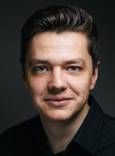Main content
Top content
Pascal Nieters

Tel.: +49 541 969-7090
Room 50/214
Institute of Cognitive Science,
Wachsbleiche 27,
49090 Osnabrück, Germany
Supervisor
Active dendrites implement probabilistic temporal logic gates
I’m interested in learning algorithms for neural networks both as models of computation in the brain and as machine learning and artificial intelligence tools. During my PhD I hope to contribute to the understanding of unsupervised dynamics in neural nets and how they facilitate discovery of immediate and latent features of its input, as well as maintenance of relevant information from the past: memory.
Current Projects:
Delay-coupled reservoirs facilitate memory dependent prediction and forecasting of time-series via complex, non-linear delay-coupled dynamics. While the mathematics and theoretical understanding of these systems is hard, applying them in practice is much easier. How can we use deeper insights about the system’s dynamics to apply the algorithm to a wider array of machine learning problems?
Training a recurrent neural network to maintain a longer short-term memory of relevant information in an input sequence via backpropagation is difficult due to properties of gradient-based, iterative optimization. The seminal Hochreiter and Schmidhuber paper “Long short-term memory” [1997] solves the problem by introducing a much more complex network architecture, the LSTM cell, that has proved wildly successful in deep learning architectures on problems ranging from translating language to recognizing objects in images. In its footsteps, other algorithms have been developed to ensure backpropagation works for recurrent networks. Can we instead use unsupervised methods to take care of maintaining memory in a recurrent network? How do the brains plasticity mechanisms help solve this task, and what is the objective a plastic and dynamic network optimizes?
Publications
R Vortmeyer-Kley, P Nieters, G Pipa (2021) A trajectory-based loss function to learn missing terms in bifurcating dynamical systems. Scientific reports 11.1 (2021): 1-13.
P Nieters, J Leugering, G Pipa (2017) Neuromorphic computation in multi-delay coupled models
IBM Journal of Research and Development 61 (2/3), 8: 7-8: 9
Pre-print:
J Leugering, P Nieters, G Pipa "A minimal model of neural computation with dendritic plateau potentials." bioRxiv (2021): 690792.
Book chapter
J Leugering, P Nieters, G Pipa (2019) Computational Elements of Circuits from “The Neocortex,” edited by W. Singer, T. J. Sejnowski and P. Rakic. Strüngmann Forum Reports, vol. 27, J. R. Lupp, series editor.
Cambridge, MA: MIT Press. ISBN 978-0-262-04324-3
Patent related to the RTG project:
Leugering, Johannes, Pascal Nieters, and Gordon Pipa. 2021. Neuromorphic Pattern Detector and Neuromorphic Circuitry Herewith. DE:102019134044:A1. Patent, filed December 11, 2019, and issued June 17, 2021.


